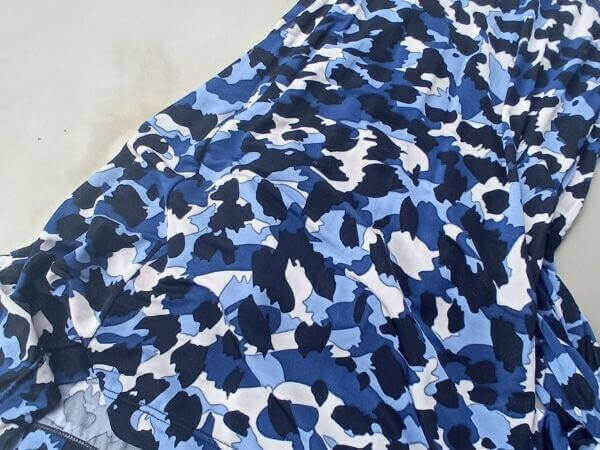Rayon wears its “artificial silk” or “art silk” badge with pride thanks to its many properties that are similar to those of naturally luxurious silk. Like silk, rayon boasts a decent amount of sheen and smoothness.
Not only does this highly-absorbent and comfortable cellulose-based fabric lend itself to different uses from making cool Hawaiian shirts to beautiful blouses and lovely lingerie, but it’s also way cheaper than genuine silk. But there’s one question that regular consumers and starting seamstresses frequently ask about rayon: Does rayon shrink?
Does Rayon Shrink in the Dryer or When Washed?
Yes, rayon shrinks when washed, even in cold water, and it shrinks even more when put into a dryer. Washing rayon on the hottest setting or tumble-drying it is the quickest way to shrink it. If shrinkage isn’t a result you want, washing your Hawaiian rayon shirt hot is a bad idea.
But there’s one instance where shrinkage might be a good thing — if the shirt or any other garment is slightly larger than your size. In this case, washing it hot can shrink the rayon shirt down to a better-fitting size.
Related: How to Shrink a Shirt
How Much Does Rayon Shrink?
When it comes to shrinking during washing or machine-drying, not all fabrics behave the same. Cotton is one of the fabrics that shrink most in all care-related conditions. Textile technologists estimate that 100% cotton clothes contract between 5% and 20% when shrunk.
As for rayon, it’s a semi-synthetic /quasi-natural fiber produced from cellulose, just like cotton and linen. And it shrinks quite a bit. But there’s no definite shrinkage percentage when it comes to rayon.
The extent to which rayon shrinks depends on how you care for it — specifically how you wash it and dry it. Machine-drying rayon can cause some serious shrinkage if it won’t damage the item in some way.
Is Rayon Synthetic?
It’s easy to think that rayon is a 100% synthetic fiber, but rayon isn’t synthetic. This luxurious, useful fabric is made using a natural material called cellulose. This raw material comes from sources such as bamboo and beech trees. It’s the exact same material found in natural fibers such as cotton and linen.
But when producing rayon, textile engineers pass the fibers through extensive chemical processes that give rayon that distinct sheen and feel we all love. The production processes alter the cellulose in various ways, eventually regenerating the cellulose. Read more about the chemistry of rayon here.
Since rayon is manufactured using natural fibers, it’s prone to shrinking when exposed to unfavorable conditions.
Rayon vs. Viscose
What’s the difference between rayon and viscose? Viscose is a type of rayon. But unlike rayon which is made from natural cellulose from plants such as bamboo or beech, viscose is manufactured using an organic liquid developed from cotton linter or wood pulp. Both fibers are produced using similar processes, but the materials used aren’t the same.
While both have the usual rayon sheen, viscose rayon is a tad softer. Finally, viscose tends to be less durable compared to other types of rayon such as polynosic, tencel, Lyocell, super-absorbent, and flame-retardant rayon.
Like other kinds of rayon, viscose rayon drapes amazingly well. This makes it a great fabric for sewing curtains and draperies. It’s also great for producing lightweight summer clothes.
Rayon vs. Cotton: Similarities and Differences
Below is a quick lowdown on the differences and similarities between cotton and rayon.
Where the Fiber Originates
Cotton comes from the cotton plant while rayon is produced by modifying cellulose. Cotton boasts tons of tensile strength, and it’s much stronger and more durable than rayon. In fact, rayon doesn’t hold up very well to wetness. But with proper care, rayon can last reasonably long.
Ability to Hold Shape, Pilling, and Wrinkles
In terms of holding shape, rayon retains its original shape pretty well and doesn’t pill much. Cotton tends to stretch with time and is more prone to pilling. But cotton is really soft, one of the softest fabrics ever created. As for rayon, it’s relatively soft, softer than most synthetic fabrics. But it’s not nearly as soft as cotton.
When it comes to elasticity, rayon refuses to budge for the most part and sees little elasticity unless it’s combined with stretchy spandex. By comparison, cotton is a bit elastic, especially knitted cotton garments. That said, rayon can stretch a lot when wet because it’s more absorbent than cotton and water weakens it. Also, rayon wrinkles, but it doesn’t form wrinkles to the same extent cotton does.
Production Processes: Which Is More Eco-friendly, Cotton or Rayon?
When it comes to eco-friendliness, neither fiber wins. Even though cotton plants are a renewable resource, the production process involved isn’t eco-friendly.
Rayon comes from natural sources, but the harmful chemical engineering processes it undergoes makes it significantly less eco-friendly. Remember that trees have to be cut to provide cellulose for manufacturing rayon. Cutting trees harms the environment in many ways.
But it gets worse. The chemical processes involved in rayon’s production are so environmentally toxic that they fall short of the EPA’s National Emission Standards. Still, rayon is more eco-friendly compared to most synthetic fibers. However, it’s not as eco-friendly as organic cotton. Organic cotton is cotton that’s grown without using manufactured fertilizers/synthetic fertilizers and other toxic chemical compounds.
Cost of the Fabric
Which is more expensive, cotton or rayon? Cotton fabrics cost more than rayon fabrics. Because cotton is cotton and rayon is…rayon.
Fabric Care: Cotton vs. Rayon
Concerning fabric care, cotton is much easier to care for compared to rayon. You can safely machine-wash cotton clothes, but rayon clothes typically need to be hand-washed or dry-cleaned.
Cotton can be machine-dried, but rayon doesn’t react too well to tumble drying. But if you air-dry both fabrics, rayon will dry faster than cotton even though it demonstrates a higher absorbency rate.
Fabric Versatility
Both fabrics are versatile, but cotton is more versatile than rayon. Rayon is mostly used to make lightweight summer clothing while cotton is used to make all kinds of clothes, bedding, bandages, feather-soft baby blankets, and more. Speaking of baby blankets, consider getting a Sherpa blanket for your little one. Because Sherpa rocks!
How to Wash Rayon Clothes Properly
Check the care label before washing any rayon clothing. This is because some rayon clothes are “Dry-Clean Only” while others need hand-washing. Machine-washing rayon isn’t recommended. Below is the step-by-step process of washing rayon clothes and other items:
- Fill a tub or sink with clean, cold water.
- Add a reasonable amount of mild soap. You can add some bleach to brighten your rayon clothes if you choose to, but be careful. Rayon care tip: While you can bleach rayon, you shouldn’t use any kind of chlorine bleach. Instead, use oxygen bleach such as Nellie’s Oxygen Brightener.
- Put the rayon garment into the cold soapy water and leave it soaked for about 30 minutes.
- Then gently hand-wash the garment. Can you hand wash rayon if the care label says “Dry Clean Only”? No, you can’t and shouldn’t. Why? Because hand washing “dry clean only” rayon can cause irreversible fabric damage.
- If you must machine-wash your linen clothes, toss the item in a wash bag and then load it. Make sure to select a delicate setting.
- Rinse the item in cold water.
- Hang the item out to dry and don’t succumb to the temptation of putting it into the drying machine because that’s one way to degrade it.
How to Iron Rayon Clothes
Here’s the correct way of ironing rayon clothes:
- Turn the garment inside out. I assume the garment is clean and dry.
- Select a low-heat setting on your iron. You shouldn’t steam rayon clothes — if you do so, shrinking might happen. Even though rayon is similar to silk in many ways, DO NOT iron it on the silk setting because it isn’t tough enough for that. Instead, select the rayon/synthetic setting, and I believe your iron has this setting because many irons come with the setting.
- Focus on one small portion of the garment before moving on to another to prevent stretching.
How to Store Rayon Clothes
The best way to store rayon clothes is to wash and dry them properly before folding them and putting them in mesh cloth bags. They need to stay flat while in storage. But you can also hang them if you like before bagging them and stowing them away. Don’t store rayon clothes or any other kind of clothes in plastic bags because clothes need to breathe while in storage.
Rayon FAQs
Below are a couple of questions consumers of all stripes keep asking about shrinking rayon.
Does Rayon Shrink?
Yes, rayon shrinks. It may shrink more or less than cotton and other natural fibers depending on how you handle it.
How Much Does Rayon Shrink?
Unlike cotton and linen which are expected to shrink 5% or more under certain conditions, it’s hard to predict how much rayon will contract. How much rayon shrinks majorly depends on what you do to it and to what degree.
How Do You Keep Rayon from Shrinking?
To keep rayon from shrinking:
- Don’t machine-wash it, even in cold water. Instead, always hand-wash it in cold water or dry-clean.
- Don’t tumble-dry it.
- If the care label says to dry-clean only, stick to that. And when in doubt, ALWAYS dry-clean it.
- Don’t hot-steam rayon unless you’re trying to shrink it.
Is Rayon a Good Material?
Yes, rayon is a pretty good material, one that manufacturers use to make a miscellany of textile products from blouses, colorful shirts, skirts, underwear, bed sheets, and whatnot. But this fabric isn’t without its fair share of disadvantages.
What’s Bad About Rayon?
Rayon isn’t known for durability. And no matter how much it pretends to be silk, it’s not and never will be silk — it’ll always be faux silk. Also, normal machine-washing can cause rayon to shrink or stretch in some cases. And while the fabric reacts well to dyeing or printing, it’s prone to bleeding color onto other clothes. Plus, it wrinkles, and it’s not the most environmentally friendly textile.
Is Rayon Better Than Cotton?
Both fabrics have certain strengths and weaknesses that make each better or worse than the other. For example, rayon has a distinct silky feel and look, and it’s super supple and drapes better than most. But it’s not as strong, soft, durable, breathable, versatile, and easy-to-care-for as cotton.
Both fibers are versatile and popular. Textile manufacturers use them to make all kinds of comfortable summer wear including really wicked shirts and cute summer dresses.
What’s Rayon Made of?
Rayon is made from cellulose, but this natural material passes through a whole battery of chemical processes designed to give the fabric certain desirable characteristics.
Can You Machine Wash Rayon?
It’s not a good idea to machine-wash rayon. It’s best to hand-wash it in cold water with a mild detergent. If you insist on machine-washing it, wash the fabric on the delicate cycle (low-spin cycle) in cold water. Be sure to put the rayon shirt or whatever into a washing bag and turn it inside out before cranking up the washer.
Can You Dry Rayon in a Dryer?
It’s not recommended to machine-dry rayon clothes as doing this tends to weaken the integrity of the fibers, progressively destroying the item.
What’s the Correct Way to Wash Rayon Clothes?
Manufacturers almost always recommend hand-washing rayon in cold water or dry-cleaning it. Machine-drying is highly discouraged. If you’re not sure whether to hand-wash it or dry clean it, dry clean it.
What Are the Pros and Cons of Rayon?
Pros: rayon has the sheen of silk and drapes like a dream. Also, it’s comfortable and versatile and is used to make all kinds of textile products including bed sheets and summer apparel. What’s more, it’s easy to dye or print, which is why it’s available in all kinds of beautiful hues and patterns. Also, it drapes excellently, and while not as soft as cotton, it’s quite soft.
Cons: rayon isn’t very long-lasting, and colors tend to fade pretty fast. Also, regular machine-washing can result in shrinkage or even stretching. In addition, rayon can bleed color onto other clothes. Plus, while it’s touted as an eco-friendly fabric, it’s made using highly toxic chemical processes, and its raw material (cellulose) comes from trees. Also, it’s not easy to wash.
Wrapping Up
Yes, rayon shrinks since it’s made from natural materials, cellulose. Since it’s a natural fiber to a large extent and absorbs lots of water, it does shrink significantly under certain conditions.
This fabric is particularly prone to shrinkage when washed in not water or when machine-dried on a high temperature setting.
If you bought a slightly oversize rayon shirt or whatever, you might be able to contract it a bit and perhaps make it fit you better. But no one ever buys a shirt because it’s shrinkable!





